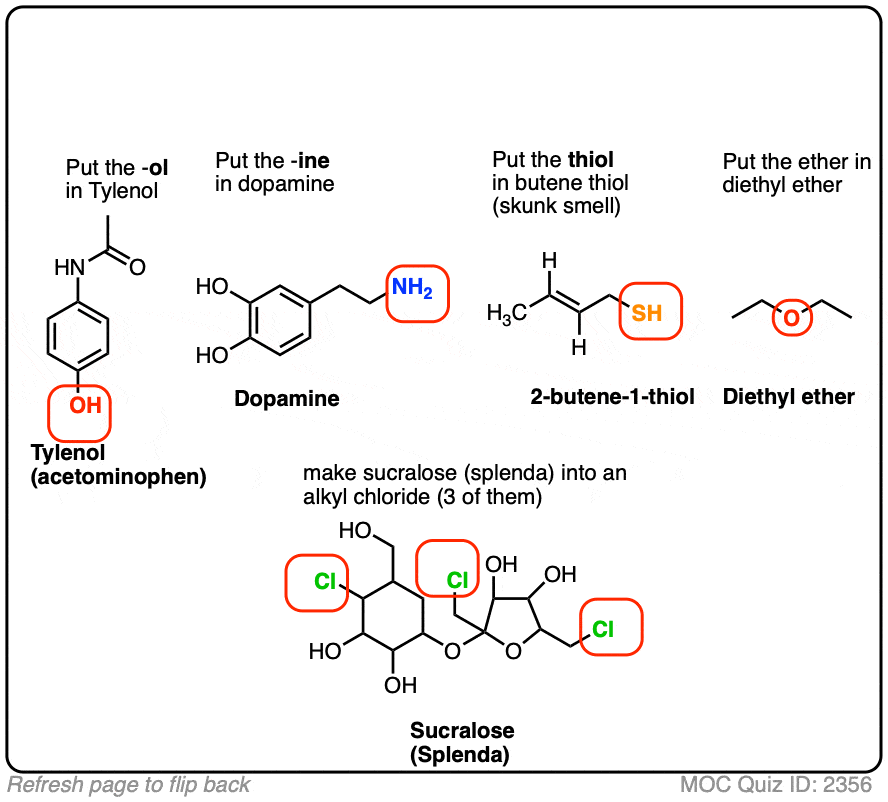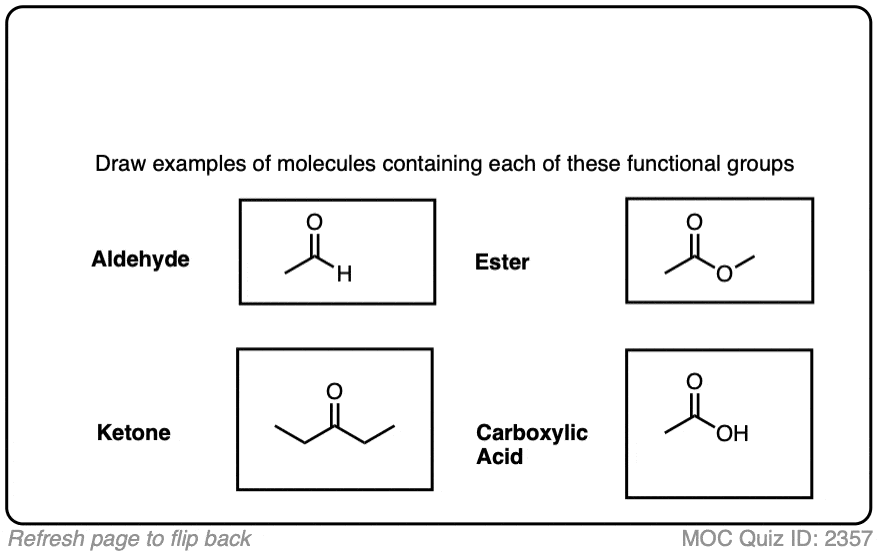All About Functional Groups
- Functional groups are specific groupings of atoms within molecules that have their own characteristic properties, regardless of the other atoms present in a molecule.
- Common examples of functional groups are alcohols, alkenes, alkynes, amines, carboxylic acids, aldehydes, ketones, esters, and ethers, among others.
- In a typical sophom*ore organic chemistry course, there are about 15 key functional groups, with another group of 10 or so that make consistent appearances. You’ll meet others, too – this is just a selection of the most common.
Table of Contents
- Functional Groups
- Alkanes, Alkenes, Alkynes, and Aromatic Rings
- Alcohols, Ethers, Amines, Thiols, Alkyl Halides
- Aldehydes, Ketones, Carboxylic Acids, and Esters.
- Amides, Acid Halides, Anhydrides, Nitriles
- Miscellaneous: Epoxides, Thioethers, Nitro, Imine, Azide
- Notes
- Quiz Yourself!
- (Advanced) References and Further Reading
1. Functional Groups
A functional group is what we call specific groupings of certain atoms within molecules that have their own characteristic properties.
Here are some of the most commonly encountered functional groups. Note that “R” is a placeholder for a generic carbon substituent.

A second group of slightly less commonly encountered functional groups are here. This is by no means an exhaustive list, but it’s at least a good start.

In the beginning of the course, being presented with a list of 20-25 functional groups to remember might seem like a lot. And it probably is!
The good news is that you’ve already learned a lot of functional group names without trying too hard.
Do these names sound familiar?
Propane. Tylenol. Ibuprophen. Testosterone. Dopamine.
Learning functional groups will be a matter of connecting those names to general structures.
Another good way to get to know functional groups is to think about the relativeelectronegativities of the elements in each group. That will help you understand their properties and help you think about how they behave in chemical reactions.
2. Alkanes, Alkenes, Alkynes, and Aromatic Rings
The hydrocarbon functional groups are very non-polar and tend to be extremely weak acids.
In hydrocarbons, the only types of intermolecular interactions are London dispersion forces and their boiling points tend to be quite low, relative to molecules containing more polar functional groups.

Alkanes are hydrocarbons containing no multiple bonds. Alkane substituents are called alkyl groups, which refers to alkanes lacking a C-H bond such as methyl, ethyl, or propyl.
- Common examples of alkanes are methane, ethane, propane, butane, and octane.
- The C-H bond is highly covalent and alkanes are very non-polar. They do not mix with water.
- Alkyl carbons are sp3 hybridized and have tetrahedral geometry about the carbon.
- You can often think of alkyl groups as the “spectator” functional groups of organic chemistry, abbreviated as R-. With the exceptions of free-radical substitution and, of course, combustion, alkanes don’t undergo a huge number of different reactions. They tend to provide the backbone of most organic molecules.
Alkenesare hydrocarbons with one or more carbon-carbon double bonds.
- Common examples are ethene, propene, and butene.
- Alkene substituents are called alkenyl groups; vinyl is often used to refer to -CH=CH2 .
- Alkenyl carbons are sp2 hybridized, with a trigonal planar geometry.
Alkynescontain a carbon-carbon triple bond.
- Ethyne (acetylene) is the simplest alkyne; alkynes are sometimes called acetylenes.
- Alkyne substituents are called alkynyl groups.
- Terminal alkynes have a C-H. Internal alkynes have C-C bonds at each end.
- Alkynyl carbons are sp hybridized with a linear geometry.
Benzene rings are six-membered rings containing 3 double bonds. Benzene rings are common in nature due to a property called aromaticity (nothing to do with its smell) that make them unusually stable. Can also be drawn as a hexagon with a circle.
- Benzene, methylbenzene (toluene) is responsible for the smell of model airplane glue.
- Benzene substituents C6H5– are called phenyl groups.
- The carbons in benzene are sp2 hybridized with trigonal planar geometry.
Draw examples of alkanes, alkenes, alkynes, and aromatic rings.
 Click to Flip
Click to Flip

The following molecules lack substituents. Draw them in.
3. Alcohols, Ethers, Amines, Thiols, Alkyl Halides
These functional groups are considerably more polar due to the greater difference in electronegativities between the bonding atoms.

Stronger intermolecular forces are present in these functional groups due to the dipole-dipole interactions. Additionally, alcohols and amines are capable of hydrogen bonding, which further increase boiling points.
AlcoholsR-OH contain carbon bonded to the hydroxyl group -OH.
- Common examples include methanol, methanol, isopropanol.
- The O-H bond is highly polarized and participates in hydrogen bonding.
- Hydroxyl groups also increase water solubility.
- Alcohols are weak acids and can also act as Lewis bases.
- Hydroxyl groups bonded to C=O are considered to be carboxylic acids, a separate functional group (see below)
Ethers R-O-R are oxygen atoms flanked by two bonds to carbon.
- Diethyl ether, tetrahydrofuran, and dioxane are ethers that are commonly used as lab solvents.
- Ethers cannot serve as hydrogen-bond donors, so their boiling points are lower than those of alcohols of equivalent molecular weight, but higher than those of hydrocarbons due to greater dipole-dipole forces.
Alkyl halides have functional group R-F, R-Cl, R-Br, R-I where R is an alkyl group.
- Bromobutane, methyl bromide, and chloroform are all examples of alkyl halides.
- Dipole-dipole interactions lead to higher boiling points than those found in alkanes.
- If R is alkene, they are alkenyl halides.
- Very important functional groups for substitution and elimination reactions.
Amines contain the functional group -NH2, -NHR, or NR2 where R is a hydrocarbon.
- Morphine, codeine, and cocaine are just three of many prominent molecules that contain amines.
- Amine substituents are known as amino groups.
- Amines with N-H bonds are capable of hydrogen bonding, which leads to higher boiling points and water solubility.
- The lone pair on the nitrogen can act as a base.
Thiols (mercaptans) R-SH are the sulfur-containing cousins of alcohols.
- The sulfur atom is not nearly as electronegative as oxygen, so the S-H bond is considerably less polarized.
- Thiols can act as weak acids; stronger acids than alcohols.
- Thiols are most notorious for their strong stench; ethanethiol is added to natural gas to give it its characteristic smell.
Draw examples of each of these functional groups.
 Click to Flip
Click to Flip

Draw in the functional groups of these famous molecules.
 Click to Flip
Click to Flip

4. Aldehydes, Ketones, Carboxylic Acids, Esters
The C=O group is referred to as the carbonyl group. The C=O bond is strongly polarized towards oxygen and the carbon bears a partial positive charge.
Carbonyls are found in aldehydes, ketones, esters, and carboxylic acids.

Aldehydes RCHO have C=O bonded to carbon and to C-H
- Formaldehyde, acetaldehyde, and benzaldehyde are common examples.
- They have polar covalent bonding but are not hydrogen bond donors
Ketones RC(O)R have C=O bonded to two carbons.
- Acetone (2-propanone) is nail polish remover.
Carboxylic Acids RCOOH have a carbonyl bonded to -OH. They are distinct functional groups from alcohols.
- Acetic acid (vinegar) and formic acid are the simplest carboxylic acids. Other short-chain acids like butanoic and pentanoic acids are notorious for their locker-room smells (or worse).
- The hydroxyl group participates in hydrogen bonding and carboxylic acids have higher boiling points as a result.
- Despite the name, carboxylic acids tend to be relatively weak acids, not undergoing full dissociation in water (as compared to strong acids such as HCl and H2SO4).
Esters RCOOR are similar to carboxylic acids, except the O-H bond is replaced with an O-C bond.
- Esters are notable for their sweet smells
- Contain polar bonds, but do not participate in hydrogen bonding.
Draw an example of an aldehyde, ketone, carboxylic acid, and ester
 Click to Flip
Click to Flip

Draw in the functional group for these prominent molecules.
 Click to Flip
Click to Flip

5. Amides, Acid Halides, Anhydrides, Nitriles
There are actually quite a few important functional groups containing carbonyls. These functional groups are all considered to be derived from carboxylic acids, as they can be obtained through replacement of OH with various groups. (Nitriles might not appear to be related to carboxylic acids at first glance, but they can actually be converted into amides through dehydration.)

Amides contain a carbonyl carbon attached to an amino group.
- Amino acids linked together through formation of an amide are known as peptides.
- Amides containing N-H bonds can participate in hydrogen bonding.
Acid Halides have -OH replaced with F, Cl, Br, or I.
Anhydridescontain an oxygen flanked by two carbonyls. Distinct from esters.
- Anhydrides can be formed from two equivalents of a carboxylic acid with accompanying loss of H2O, hence the name.
Nitriles don’t look like carboxylic acid derivatives at first, but they can be formed via the dehydration of amides.
- Acetonitrile is a common solvent.
- “Nitrile gloves” are made from nitrile rubber, a co-polymer of butadiene and acrylonitrile.
- The -CN substituent is sometimes referred to as a cyanide.
- HCN, hydrogen cyanide, is a highly toxic gas. The cyanide ion (-)CN, is often encountered in introductory courses (on paper, not in the lab!)and undergoes reactions with alkyl halides.
Draw in examples of an amide, acid halide, anhydride, and nitrile.
 Click to Flip
Click to Flip

Fill in the functional groups of these famous molecules.
 Click to Flip
Click to Flip

6. Miscellaneous: Epoxides, Thioethers, Nitro, Imine, Azide
No common thread here; just a few more prominent functional groups worth knowing.

Technically, Epoxides are ethers, but since they participate in a number of reactions that ethers generally don’t , they deserve their own category.
Thioethers (sulfides) are the sulfur equivalents of ethers. Dimethyl sulfide is the most commonly encountered example.
Nitrogroups are strongly electron-withdrawing. Nitromethane, a solvent, is the simplest example of a nitroalkane.
Iminesare the nitrogen-containing equivalents of aldehydes and ketones.
Azides pop up from time to time. The “A” in the anti-HIV drug AZT stands for azido.
Draw in the functional groups in these molecules.
 Click to Flip
Click to Flip

7. That’s Probably Enough For Now
Of course there are more functional groups that you will encounter, but this list should be sufficient for most students in an Org 1 course. Past a certain point, the law of diminishing returns starts to apply.
The sooner you try to get beyond knowing the name of a functional group and start to apply concepts like electronegativity and resonance, the more “alive” each of these functional groups will seem to you.
Notes
Related Articles
- Primary, Secondary, Tertiary, Quaternary In Organic Chemistry
- How to apply electronegativity and resonance to understand reactivity
- How To Find The Best Resonance Structure By Applying Electronegativity
- Don’t Be Futyl, Learn The Butyls
- Alcohols Nomenclature Properties
- The Amide Functional Group: Properties, Synthesis, and Nomenclature
Quiz Yourself!
 Click to Flip
Click to Flip

 Click to Flip
Click to Flip

(Advanced) References and Further Reading
- Relating Functional Groups to the Periodic Table
Jef Struyf
Journal of Chemical Education 2009 86 (2), 190
DOI: 10.1021/ed086p190 - Learning the Functional Groups: Keys to Success
Shannon Byrd and David P. Hildreth
Journal of Chemical Education 2001 78 (10), 1355
DOI: 10.1021/ed078p1355

